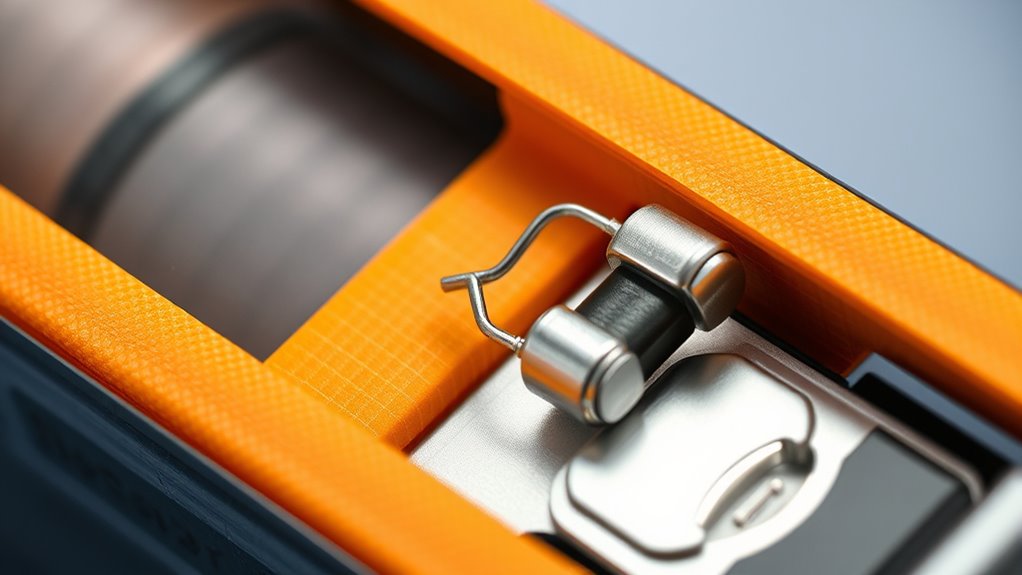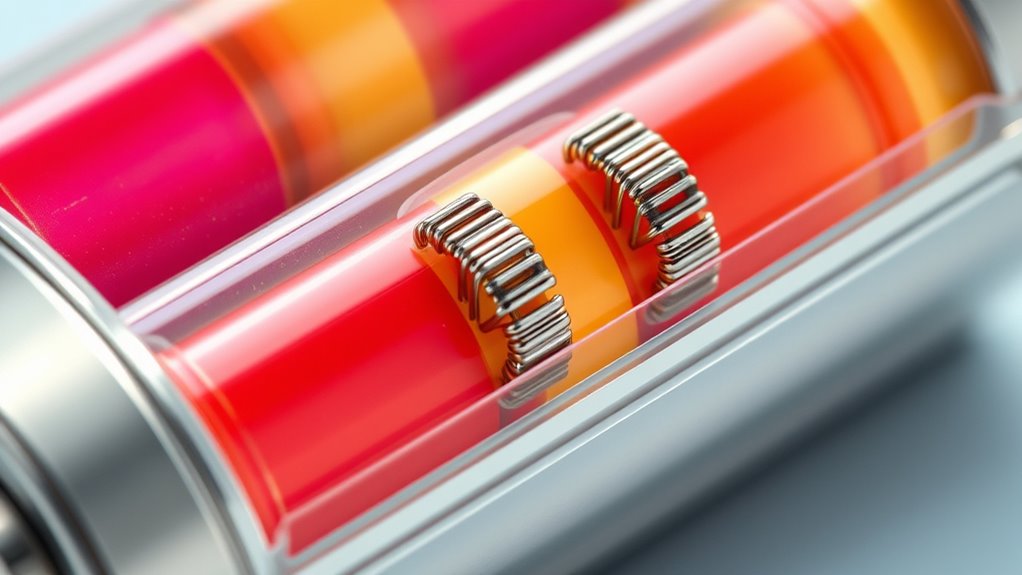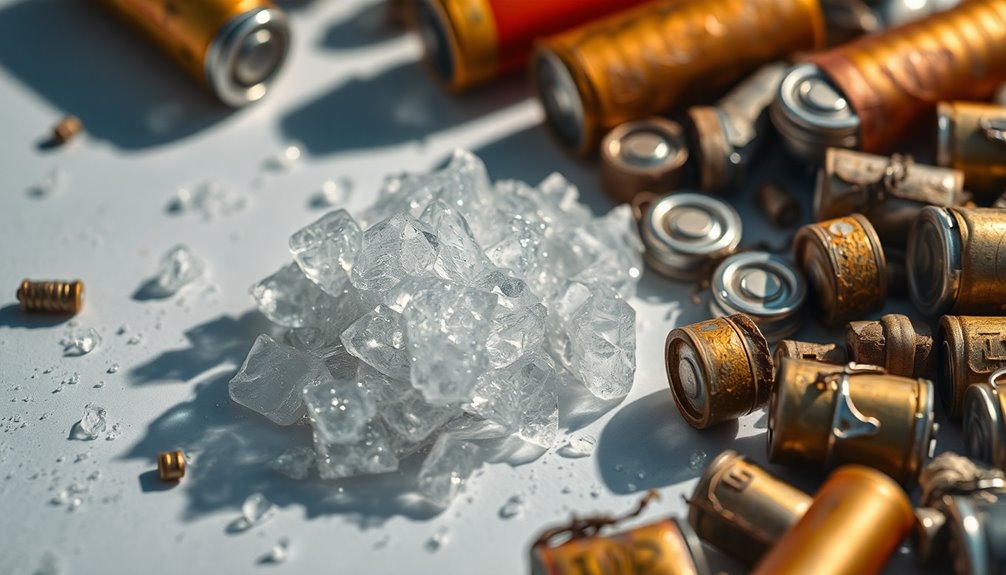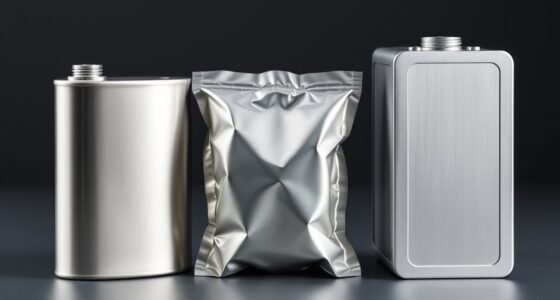In battery design, separators and thermal fuses work together to keep you safe. Separators act as barriers between the anode and cathode, preventing internal shorts even if the battery is damaged. Thermal fuses automatically disconnect the flow of electricity if overheating occurs, stopping potential fires or explosions. By combining these safety features with thermal management and protective casing, batteries are made more dependable and secure. Keep exploring to discover how these components ensure your devices’ safety.
Key Takeaways
- Separators prevent internal short circuits by acting as insulating barriers between electrodes.
- Made from mechanically robust, electrically insulating materials to withstand internal and external stresses.
- Thermal fuses automatically disconnect the battery when overheating is detected to prevent thermal runaway.
- Thermal fuses serve as active safety components, halting heat generation during thermal faults.
- Combining separators and thermal fuses enhances overall safety by preventing electrical and thermal failures.

Battery design has become increasingly focused on safety features to prevent accidents and guarantee reliable performance. When you’re dealing with batteries, especially in high-demand applications like electric vehicles or portable electronics, ensuring safety isn’t just an afterthought—it’s a core priority. Two key aspects that manufacturers emphasize are thermal management and mechanical safety, which help mitigate risks associated with overheating, short circuits, or mechanical damage. Proper thermal management keeps the battery’s temperature within safe limits, preventing thermal runaway that can lead to fires or explosions. This involves integrating materials and design strategies that dissipate heat effectively, like advanced cooling systems or heat-absorbing separators. Without these measures, a small malfunction could escalate into a critical safety hazard. Additionally, the choice of separator material affects the overall color fidelity and safety of the battery, ensuring consistent performance over time.
Mechanical safety is equally essential, especially considering the physical stresses that batteries encounter during handling, installation, or operation. You need to be confident that a battery won’t rupture, leak, or short-circuit if dropped or subjected to external impacts. That’s why separators are designed to act as a physical barrier between the anode and cathode, preventing internal short circuits even if the internal structure gets compromised. These separators are made from materials that are both electrically insulating and mechanically robust, reducing the risk of internal damage causing a fire or failure. Additionally, mechanical safety features often include protective casing and cushioning to absorb shocks, further preventing damage that could lead to safety incidents.
Thermal fuses are another essential safety component incorporated into battery design. When a battery overheats beyond a safe threshold, these fuses automatically disconnect the electrical flow, halting any further heat generation. This active safety feature acts like a built-in safeguard, preventing thermal runaway from escalating and reducing the chance of fire. Combined with thermal management systems, thermal fuses help guarantee that even if a fault occurs, the situation remains contained. As you handle or use batteries, these safety features work behind the scenes to protect you from potential hazards, ensuring the device operates reliably over its lifespan.
In essence, modern battery design prioritizes safety through a combination of thermal management, mechanical safety measures, separators, and thermal fuses. These components work together to prevent overheating, internal shorts, and mechanical failures, which could otherwise result in catastrophic consequences. By integrating these features, manufacturers provide greater peace of mind, allowing you to use batteries confidently, knowing they’re engineered to prevent accidents and perform safely under various conditions.
Frequently Asked Questions
How Do Separators Prevent Internal Short Circuits?
Separators prevent internal short circuits by acting as a physical barrier between the positive and negative electrodes, preventing direct contact. Their function is to keep the electrodes apart while allowing ion flow, which is vital for battery operation. By maintaining this separation, separators effectively prevent internal short prevention, reducing the risk of overheating or fire. They are essential for ensuring the safety and longevity of your battery.
What Materials Are Used in Thermal Fuse Construction?
Fuses typically use materials like metal alloys, glass, or ceramics, chosen for their specific thermal fuse properties. These fuse materials are designed to melt or break when exposed to high temperatures, preventing overheating. The fuse’s core function is to safely disconnect the circuit when thermal fuse properties indicate excessive heat, ensuring safety. You’ll find these materials carefully selected to balance reliability, responsiveness, and durability under extreme conditions.
Can Safety Features Affect Battery Performance?
Safety features can impact your battery’s performance by improving longevity and maintaining charging efficiency. When you include separators and thermal fuses, they help prevent overheating, reducing wear and tear. This means your battery stays healthier longer and charges more efficiently. While these safety measures might add minimal resistance, they ultimately guarantee your battery performs reliably and lasts, protecting your investment and enhancing overall user experience.
How Are Safety Features Tested During Manufacturing?
During battery manufacturing, safety features are rigorously tested as if you’re inspecting a high-stakes, life-or-death mission. You run explosive stress tests, thermal runaways, and electrical overloads to verify separators and thermal fuses activate perfectly. Quality control teams push every component to its limits, simulating extreme conditions to confirm safety features protect you. This intense testing guarantees your battery’s safety without compromising performance, giving you peace of mind.
Are Safety Features Effective in All Battery Types?
Safety features like separators and thermal fuses are generally effective across various battery types, but their efficiency depends on chemical stability and design. You should know that some battery chemistries, like lithium-ion, require additional safety measures due to higher risks. Always make certain your battery’s safety features are properly integrated and maintained, as they play a vital role in protecting user safety and preventing thermal runaway or other hazards.
Conclusion
By understanding safety features like separators and thermal fuses, you can greatly reduce the risk of battery failures. Did you know that nearly 60% of battery fires are caused by internal short circuits? Incorporating these safety measures isn’t just smart—it’s essential for protecting yourself and your devices. Stay informed and choose batteries with advanced safety features to ensure reliable, safe performance every time you use them.










